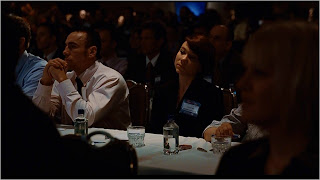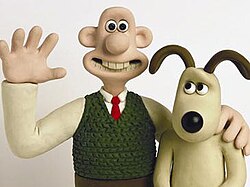At the end of the film Up in the Air, our main character Ryan Bingham experiences a profound crisis. This internal upheaval is translated to the screen by controlled artistic use of the camera - framing, lighting and composition all play a role in subtly painting the story for the audience. The result is one of the most powerful scenes in recent memory.

1. The opening shot takes place at a Las Vegas convention center, with Ryan giving his signature presentation at the venue he’s always dreamed of performing. His speech, in essence, highlights the advantages of living without personal connections, of always traveling light – both in physical terms and in terms of relationships. This message sums up his character. The shot reflects this worldview of his – he stands alone, in the center of the frame, without his emotions visible to us since we are looking at his back. In the background, in soft focus and low light, are numerous people. The clearly defined divide symbolizes Bingham’s isolation from the contact that makes life beautiful.
ai
1. However, the next shot stands in contrast. We are allowed a medium close up with ample lighting – and only Bingham in the frame. This allows us to both see the expression on his face (one of defeat and recognition of the sorry state of affairs he has grown himself into) and see visually his recognition of isolation.
1. Soon afterwards the camera guides us back to the audience. In low lighting, with faces in varying degrees of focus, the effect is alienating. These people are strangers, indicated by their number and lack of focus, and they look up at Bingham from the darkness, essentially yearning for answers and validation from his speech. The pressure on him to make his choice – continue speaking and accept what his life has become, or stop and confront his identity crisis – weighs heavy with the tension brought from this shot.
1. The choice is finally symbolized in the next shot. Bingham is positioned in half of the frame, with nothing in particular occupying the half in front of him. He is metaphorically facing and standing up to something he can’t see – his own flawed sense of self.
1. The next shot is tight on Bingham’s face as he rushes off the stage after only a few moments of speaking. His destination: the one woman who he has been able to make a connection with that runs deeper than business. Once again, the faces he runs past are obscured, but for a different reason: they are blurred by his quick movement. The tight framing on his face allows us to see his increasingly mischievous smile as he throws off the yoke of his isolation. The faces are not – unlike the out of focus strangers – obscured to highlight his alienation, they are obscured because of his singular focus to make his only connection. He ignores all else in his pursuit.

1. Similarly, the next shot tracks him running through the airport to make the physical connection (a flight) to his emotional one. From here on out, the travel scenes are consistently left-to-right and serve as an effective transition, taking us away from the sterile convention center and to the lady’s house. The camera goes with Bingham, rather than seeing him run across the frame, to highlight his urgency and to impart that urgency on the audience.

1. The shot of Bingham reaching his gate has a very interesting composition. In it, we see him standing at the very center of the ramp. Outside of that tunnel, light streams through the windows, and down the ramp is a dark pathway. This enhances the sense of Bingham finally leaving his comfort zone. He has always relied on flying as a means to leave relationships behind, as symbolized by the abundant light, and he has used this excuse subconsciously to avoid confronting the possible sadness, love and all emotions of the unknown, represented by the dark pathway. Basically, the shot makes a bold transition for Bingham, and he takes the plunge by stepping through the gate (which has now been made into much more than an airline gate). Unfortunately, the darkness of the gate foreshadows the results of this plunge.

1. Next we are treated to a close shot of Bingham, but his eyes are the only visible part of his face as the light hits them. Notably, the light streams upwards from the ground through the airplane’s window, and his eyes are visible because they reflect that light. This lighting demonstrates, for the first time, Bingham’s longing to reach the light and love of life on the ground and to leave the alienation of his former life in the air.
1. The following shot establishes the setting as he flies into the hometown of the woman he is growing to love, as seen from the sky – an excellent way to show the setting while maintaining Bingham’s perspective.
1. Bingham hurriedly rents a car from the teenager managing the facility. The natural-seeming two shot underscores his increasing relation to other people.
1. Next is another travel shot from left to right. Bingham is placed in the left half of the frame, darkness behind him, light in front. The fact that he is taking control by driving a vehicle rather than being ferried by aircraft, coupled with the lighting, continues to paint his passage through this identity crisis as he begins to steer his life back on track. The directions placed in his hand that we clearly see his eyes flickering back to show us that he is still in an unfamiliar world.
1. The next couple of shots feature an empty neighborhood, with Bingham as a subtly glowing subject hurrying through the fairly shadowed street. The focus on him and his personal crusade remains strong.
1. Finally, he reaches the doorway of her house. He ascends up to the lit, colorful doorway, almost yearning for the life and light that must be contained inside. The shot is completely centered on him and this final barrier, maintaining the utmost focus.
1. The next shot, however, is unsettling – and for a good reason. Yes, Bingham is still in the center of the frame, he is still lit – but the camera is looking down on him from the steps. The power has been taken from him by this positioning, and he looks weak and futile as reality begins to crash down upon his fantasy of reclaiming the love and passion he has missed out on his whole life.
1. The next few shots go back and forth over the shoulder of Bingham and down upon him. The woman, Alex, is framed above him and importantly is never fully exposed by the doorway. She is visible, but only above him, and without breaking the threshold of the door. She metaphorically hides behind the doorframe. Her face grows increasingly forlorn, reflecting this dynamic. She cannot bridge the gap from her life to Ryan’s.
1. We are then treated to a very tight close up of Bingham. This brings maximum emotional impact to the scene as his face falls and he wistfully realizes that his crisis will not end in the way he so desires. We can clearly follow as his eyes sink lower and lower in utter defeat and stiffly hidden pain.
1. The sounds of Alex’s children that caused the divide are finally visible behind her. Ryan’s incredulity and her difficult-to-read sadness are interlaced as they silently come to their conclusions about the other. The shots are continuously tight to convey emotion effectively.
1. As her husband, and thus her “real life” momentarily walk into the frame, the door is literally shut in Ryan’s face. The fact that we see the door from Alex’s side cutting Ryan off visually represents Ryan being cut off from his chance at redemption. The transition is stark and brutal, just like his realization.

1. We next see Ryan sitting in his hotel room. The framing is very intricate: his head is cut off, and our only view of his face is the blurred, indistinct reflection in the hotel window. The effect is heavily depressing: as his alienation from personal relationships manifests itself once more, his own personal image and identity is torn from him. Not only are we, the audience, not granted an emotional view of his face (which reinforces his isolation), but the image in the window reflection does the same for him. This shot is as forlorn as I’ve ever seen. Sprinkled in the image are single-serving liquor bottles, which are brightly lit. The light reflects off the tiny glass bottles clearly, highlighting the fact that Ryan has nobody to share them with. The emphasis on the airport-hotel sized bottles reflect the nature of his old life that he has now returned to: sterile and lonely.

1. This striking, final shot sends a clear message with little need for intricate analysis. Ryan is trapped and isolated in the frame, in a tiny square bubble of light in the midst of a pitch black expanse. His journey of self-discovery thus comes full circle, as he once again becomes as isolated as he ever was.






































